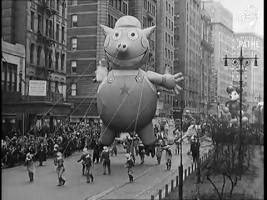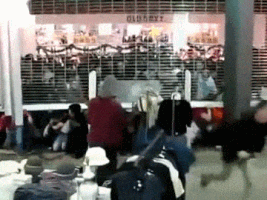We all enjoy holidays with friends and family and Thanksgiving is one of the biggest holidays besides Christmas. Nowadays, we also have Black Friday, Cyber Monday, and Super Saturday which all revolve around Thanksgiving and Christmas. But I’ll bet few of you know how it all started.
The history of Black Friday started much earlier than people think. The day after Thanksgiving was the unofficial beginning of the Christmas season since the late 19th century. President Lincoln designated the Thanksgiving holiday as the last Thursday in November. It wasn’t called Black Friday then. That’s because the  name was associated with September 24, 1869 when two speculators created a boom-and-bust in the gold market.
name was associated with September 24, 1869 when two speculators created a boom-and-bust in the gold market.
In 1905, Canadian department store Eaton’s began the first Thanksgiving Day parade by bringing Santa on a wagon through the streets of downtown Toronto. In 1913, eight live reindeer pulled Santa’s “sleigh.” By 1916, seven floats representing nursery rhyme characters joined Santa in the parade. In 1924, the Eaton’s parade inspired Macy’s Department Store to launch its famous Thanksgiving Day parade in New York City. Macy’s wanted to celebrate its success during the Roaring 20s. The parade boosted shopping for the following day. Retailers had a gentleman’s agreement to wait until then before advertising holiday sales. In 1941, Congress passed a law that made Thanksgiving the fourth Thursday in November no matter what. In the 1950s, people began calling in sick the day after Thanksgiving, essentially giving themselves a four-day weekend. 
Since stores were open, as were most businesses, those playing hooky could also get a head start on their holiday shopping — as long as the boss didn’t see them. Rather than try to determine whose pay should be cut, and who was legitimately sick, many businesses started adding that day as another paid holiday. Historically, shoppers did half their holiday shopping on Black Friday. The holiday season consists of November and December, according to the National Retail Federation. In 2011, Black Friday sales were $12.3 billion, up 2.3 percent from 2010. It was the first year that some stores opened on Thanksgiving evening. So the two days were combined. Overall holiday sales rose 4.6 percent. In 2013, combined online and store sales for the entire  Black Friday weekend were estimated at $57.4 million.
Black Friday weekend were estimated at $57.4 million.
It was lower than the $60 million spent in 2012. Many shoppers took advantage of online sales that began in early November while others waited for bigger discounts later in the shopping season. So began Cyber Monday. Cyber Monday is November 27, 2017, the first Monday after Thanksgiving. It’s expected to be the biggest shopping day of the year. Adobe Digital Insights predicts that online shoppers will spend $6.6 billion. It would replace Black Friday, which will only receive $5 billion in online sales. Cyber Monday is so popular because 75 percent of shoppers dive in first thing Monday morning. Twenty-five percent shop during lunch and 34 percent go online Monday night. Only 19 percent take advantage of Cyber Monday sales the rest of the week. Now that the shopping season is in full swing, many folk’s thoughts turn to the possibility of snow.
From what I am seeing, I continue to see signs of a major pattern flip somewhere around mid-December. The stratospheric Polar Vortex is predicted to remain stronger than normal for the remainder of November and into early December.  As the Polar Vortex grows colder and colder while it is held in place in the Arctic, sooner or later the wall of winds holding it will breakdown. One of the clues to my thoughts on December’s weather is due to a phenomenon called Rossby Waves. Atmospheric Rossby waves are giant meanders in high-altitude winds with a major influence on weather. Rossby waves are associated with pressure systems and the jet stream. These Rossby waves are responsible for day-to-day weather patterns at mid-latitudes due to the fact that low and high pressure systems form within its boundaries. Rossby waves are formed as a result of the Earth spinning. As the planet turns, blobs of air begin moving from west to east. As the blobs encounter accidents of topography—such as a mountain range—they deflect, sometimes toward the Equator. Another little-known fact is that the Earth—and the air above—has more spin at the poles than at the Equator. A blob from the north that is deflected south will find itself in a region with less spin.
As the Polar Vortex grows colder and colder while it is held in place in the Arctic, sooner or later the wall of winds holding it will breakdown. One of the clues to my thoughts on December’s weather is due to a phenomenon called Rossby Waves. Atmospheric Rossby waves are giant meanders in high-altitude winds with a major influence on weather. Rossby waves are associated with pressure systems and the jet stream. These Rossby waves are responsible for day-to-day weather patterns at mid-latitudes due to the fact that low and high pressure systems form within its boundaries. Rossby waves are formed as a result of the Earth spinning. As the planet turns, blobs of air begin moving from west to east. As the blobs encounter accidents of topography—such as a mountain range—they deflect, sometimes toward the Equator. Another little-known fact is that the Earth—and the air above—has more spin at the poles than at the Equator. A blob from the north that is deflected south will find itself in a region with less spin.
It then attempts to return to the latitude it belongs and curves back. But, it overshoots its mark and has to turn back southward. A wavy jet stream forms. When the waves get very large, they move more slowly. That means the weather they create also move more  slowly, which leads to very extreme weather that hangs around oppressively for weeks. Now that most of you are thoroughly confused, I will try to simplify what looks to be happening. After mid-December it appears a blocking pattern will set up that will turn us towards a wintery look. The Polar Vortex looks to at least partially break out of the Arctic and thanks to the Rossby Wave pattern, should pour very cold air into the eastern U.S. Remember, except for a brief escape, the Polar Vortex has been bottled up in the Arctic, surrounded by a wall of wind, and strengthening. There are signs that a Stratospheric Warming event is likely going to take place over the next two or three weeks. This will cause the winds that hold the vortex in place to weaken and allow the vortex to either break off or even displace it driving it south. This means very cold coming for the Eastern U.S. If you combine that with the blocking patterns that are expected to set up, the result would be significant wintery weather for areas east of the Mississippi River, including our area. The question is how long the blocking patterns will hold to keep the cold air in place over us. This looks to begin in about three weeks or around mid-December give or take a few days. Some of the signals are already there and the process has begun. In my opinion, starting the week before Christmas, look for the snows to begin and true winter to start in earnest. Key potential snow dates are Dec 17th, Dec 21st thru the 24th, and Dec 27th thru the 31st. While this certainly is not in concrete and things could change, I am pretty confident in what I am seeing. Feel free to comment on this post and be sure to hit the “Like” button at the end.
slowly, which leads to very extreme weather that hangs around oppressively for weeks. Now that most of you are thoroughly confused, I will try to simplify what looks to be happening. After mid-December it appears a blocking pattern will set up that will turn us towards a wintery look. The Polar Vortex looks to at least partially break out of the Arctic and thanks to the Rossby Wave pattern, should pour very cold air into the eastern U.S. Remember, except for a brief escape, the Polar Vortex has been bottled up in the Arctic, surrounded by a wall of wind, and strengthening. There are signs that a Stratospheric Warming event is likely going to take place over the next two or three weeks. This will cause the winds that hold the vortex in place to weaken and allow the vortex to either break off or even displace it driving it south. This means very cold coming for the Eastern U.S. If you combine that with the blocking patterns that are expected to set up, the result would be significant wintery weather for areas east of the Mississippi River, including our area. The question is how long the blocking patterns will hold to keep the cold air in place over us. This looks to begin in about three weeks or around mid-December give or take a few days. Some of the signals are already there and the process has begun. In my opinion, starting the week before Christmas, look for the snows to begin and true winter to start in earnest. Key potential snow dates are Dec 17th, Dec 21st thru the 24th, and Dec 27th thru the 31st. While this certainly is not in concrete and things could change, I am pretty confident in what I am seeing. Feel free to comment on this post and be sure to hit the “Like” button at the end.





